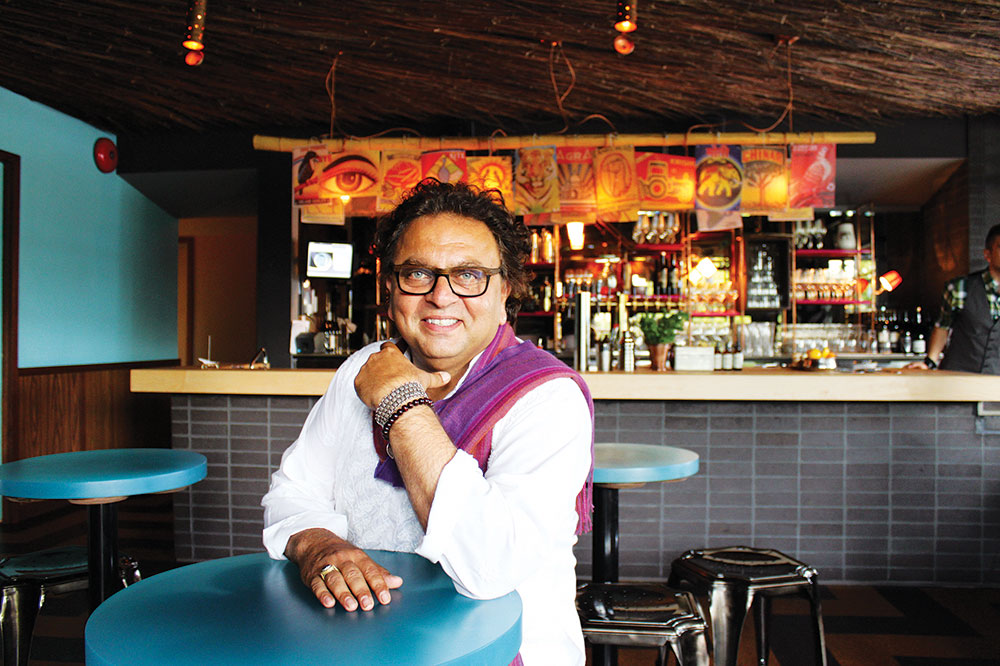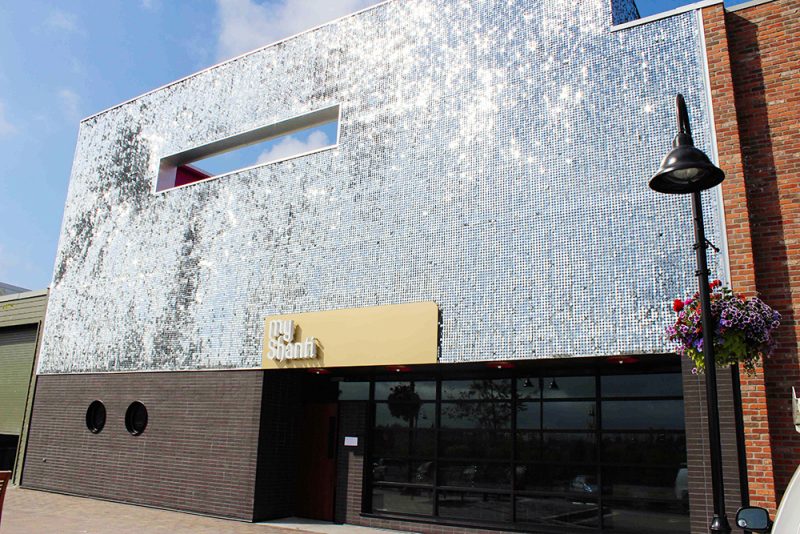Far From Easy. How (or why) does someone open a restaurant?

The restaurant business is a tough one. There are a million different facets that affect the success of the restaurant: cuisine, location, decor, service, management and the list goes on. When a restaurant succeeds to gain local, national and even international fame, the restaurateur is doing at least one thing right and has had quite a bit of luck. When that restaurateur then goes on to open several restaurants of equal or greater fame, you know that he or she is doing everything right.
Canada has a few restaurant moguls that they can call their own. Vikram Vij, owner of the Vij’s line of restaurants, is one such restaurateur. He opened Vij’s Restaurant in 1994 with the hope of proving to Vancouver, and the world, that Indian cuisine is more than just spicy. “I wanted to open a restaurant because I’m passionate about Indian cuisine and I wanted to showcase my Indian food not just as an ethnic food but as a cuisine that’s very complex, as complex as Italian and French,” says Vij. “It’s very important for people to understand that our cuisines are not just cuisines, but people’s loves and passions.”
Vij’s Restaurant was his springboard for an empire called Vij’s Inspired Indian Cuisine that includes: Rangoli, a Vancouver eat-in restaurant and packaged, take-home curry market; Vij’s at Home, their Surrey-based production headquarters that sells their packaged curries; My Shanti, also in Surrey, a restaurant where “each dish has been chosen to represent the uniqueness of a particular [Indian] region’s cuisine”; Sutra, a store that sells “frozen and refrigerated ready-to-eat Indian dishes, freshly roasted spices as well as [their] cookbooks”; and Vij’s Railway Express: their food truck restaurant that was named enRoute Magazine’s People Choice’s Award winner in 2013.
Phew, that was a mouthful!
As you can see, Vij’s food empire consists of more than just your usual eateries. He has stores, restaurants, a food truck and cookbooks, all operating with the goal of showcasing Indian cuisine. “I believe Indian food is so vast, so broad and has so many different ways of doing things,” Vij mentions. “So the central theme of my restaurants is to bring awareness of Indian cuisine and the different spices and culture of Indian.” But each of his establishments are unique in and of themselves. “Every time I’ve opened up a new restaurant … The idea was not to do copies, but to do something new.”
This focus on the cuisine has been the centre point for Vij, which means that the menu is at the forefront of his restaurants. “I create a menu I think will work really well for the demographics and the style of restaurant,” says Vij. “But some of the dishes we thought would do well were terrible and didn’t do well at all. And some of the dishes we thought were terrible did well.”
Flexibility, especially in the early stages of a restaurant is very important. “If it doesn’t work properly then I change the menu items” says Vij. “First when we opened the restaurant … menu variations were huge. Menu changes were huge.” These changes catered to the palates of his audience, rather than financial success (or lack thereof) of each dish.
Discovering how dishes are being received by the guests requires collaboration between the front and back of the restaurant. “I have a cool team of managers and I brainstorm with them — it’s not just one person, it’s four people brainstorming and that’s what I love,” states Vij. “I think that’s the key to success, giving everyone a space to express themselves.”

My Shanti by Vikram Vij in Surrey, BC
But managers are just one part of this equation. The people working the floor have a huge impact on guests’ experience — which in turn determines the success of a restaurant. “If you treat your staff really well and treat them with respect and love, then they in turn put that extra smile, extra love, extra things that are required for your customer to get great service,” explains Vij. “I make sure my staff gets respected and loved.”
While Vij makes opening restaurants sound easy, it’s far from that. “It’s important to know that just because you have money and passion, you still have to work hard to do what you want to do,” says Vij. “I worked as a sommelier, I worked in kitchens and other restaurants. It’s not luck — luck plays a very small role in the success of a restaurant. If you’re passionate and you work hard, then luck will come your way. But very few people become ‘rock stars’ overnight.”
Vij’s hard work has paid off, though not always within his desired timeline. “Whatever we’ve worked on has succeeded. Some have taken a lot longer than I expected,” he states. “It goes to show that just because you think you have the food, it doesn’t mean that people will be able to see it. It takes a long time to show that passion and love, and for people to understand. It proves that just because you have opened two restaurants doesn’t mean you can open a third and do well at it.”
Even with his lengthy resume, Vij isn’t done recreating Indian cuisine for Canadians. “In September, we’re opening a bigger Vij’s [Restaurant],” states Vij (though this conversation was held in August, so he’s probably already opened it!). He’s also working on some Toronto-based projects, “some pop up restaurants down the road. Just working on it, no concept or date yet.”
Another Canadian restaurateur making waves in the restaurant industry is Jen Agg. She’s lauded in the media for her frank and unabashed Twitter account and her commitment to creating trends. “I love opening restaurants. It’s intense, it’s horrifically stressful — but you forget how much it hurts,” Agg told Post City Toronto. “I think that the Hoof forged a certain kind of path in Toronto — not necessarily in the world, but in Toronto. … It’s an industry I really want to do another way: it’s about the diner relinquishing a bit of control.” Agg’s restaurant empire consists of The Black Hoof, Rhum Corner and The Cocktail Bar. All of these restaurants are found within one city block in Toronto (corner of Dundas and Grace).
The Black Hoof is the product of Agg’s exploration of worldwide trends with an emphasis on Spanish cuisine. “Charcuterie was always something I was eating and serving,” she told Post City Toronto. As a result, she decided to open a charcuterie with chef Grant van Gameren. “I’d been holding on to this vision for at least six months and had a solid idea of what I wanted,” she said. The idea was to serve “really delicious food but have it be a super-casual atmosphere.” This is the core theme behind The Black Hoof and one of the reasons why it became a trend-leader in Toronto’s restaurant scene.
Not all of Agg’s projects have succeeded. She opened Hoof Raw Bar, a complement to The Black Hoof that served seafood charcuterie, in 2012. But it has since closed. “I felt like I had built a beautiful, perfect room, exactly to my taste, and I loved that space,” she told Toronto Life. “We started out really strong. A lot was invested in that restaurant, and it was really hard to close. But the next day I shook it off and started building Rhum. So yeah, maybe you’ll fail, but you don’t have to be a failure.”
“You know, that was such a good lesson for me. I don’t think it was something that people didn’t get. Ultimately, I think that good restaurants, generally speaking, don’t close. So we probably missed the mark somewhere.”
Agg is continuing to expand her restaurant empire, moving her business to Montreal. With her husband, artist Roland Jean, as well as Arcade Fire’s Win Butler and Régine Chassagne, she’s launching Agrikol, a Haitian restaurant that she hopes will be similar to The Rhum Corner, but unique in its own way. “I’m thinking of it as a spin-off restaurant — like twins, but fraternal twins,” Agg told Toronto Life. “It’s going to have a menu that kind of follows the same principles, but I’m so excited because there’s so much [stuff] in Montreal, like djon-djon mushrooms, which are basically the greatest thing ever. They are so umami-packed. We can’t get them here in Toronto — we’ve tried. And having whelks all the time will be cool. There are two buildings and a courtyard, and I’m not sure what we’ll be doing with the second building, but definitely there will be art. It will be a hub.”
So what advice can we give aspiring restaurateurs? “My biggest tip to everyone is to have a long-term vision and keep going at it,” advises Vij. “Do not panic every time there’s a drop in the sales … The average restaurant takes three to five years to break even. You need to have that tenacity. You need to know you’re going to be happy and successful.”
He also believes in maintaining focus. “Focus on a theme, focus on an idea, focus on a vision to do different kinds of foods and concepts … if it doesn’t work right now, don’t run out and change it; play with it and tweak it,” says Vij. “Remain focused.”
